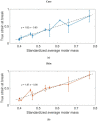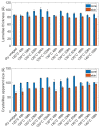Thermo-Hydro-Glycol Ageing of Polyamide 6,6: Microstructure-Properties Relationships
- PMID: 36236045
- PMCID: PMC9572785
- DOI: 10.3390/polym14194097
Thermo-Hydro-Glycol Ageing of Polyamide 6,6: Microstructure-Properties Relationships
Abstract
The microstructural evolutions occurring during the thermo-hydro-glycol ageing of an injection molded PA66 were studied. They were correlated to the evolutions of its mechanical properties. The aged samples were immersed in an antifreeze fluid-mainly composed of water and ethylene glycol-at varying times and temperatures. The aim was to combine an as exhaustive as possible microstructural investigation and a rigorous mechanical analysis. Consequently, the microstructure of the aged and unaged PA66 was assessed through the average molar mass, the diameter of the spherulites, the lamellae thickness, the crystallite's apparent size, a crystal perfection index, and a crystallinity index. Moreover, a core-skin approach was set up. The mechanical consequences of the microstructural changes were investigated by DMA and tensile testing. The local true strain fields were measured with a digital image correlation system. The temperatures and strain rates of the tests were chosen by referring to the time-temperature superposition principle. It is concluded that the water and ethylene glycol intake resulted in an intense plasticization, the loss of the molar mass resulted in the embrittling of the polymer, and finally, it was identified that the changes of the crystalline structure have an influence on the stiffness of PA66.
Keywords: PA66; mechanical behavior; microstructure; thermo-hydro-glycol ageing.
Conflict of interest statement
The authors declare no conflict of interest.
Figures




















References
-
- Puffr R., Šebenda J. On the Structure and Properties of Polyamides. XXVII. The Mechanism of Water Sorption in Polyamides. J. Polym. Sci. Part C Polym. Symp. 1967;16:79–93. doi: 10.1002/polc.5070160109. - DOI
-
- Ledieu B. Ph.D. Thesis. Arts et Métiers ParisTech; Paris, France: 2010. Aging in Water/Glycol Medium of Polyamide 66 Reinforced in Short Glass Fibers for Water End Tank of Radiator Application.
-
- Meng Q., Gu Y., Luo L., Wang S., Li M., Zhang Z. Annealing effect on crystalline structure and mechanical properties in long glass fiber reinforced polyamide 66. J. Appl. Polym. Sci. 2017;134 doi: 10.1002/app.44832. - DOI
-
- Murthy N.S., Akkapeddi M.K., Orts W.J. Analysis of Lamellar Structure in Semicrystalline Polymers by Studying the Absorption of Water and Ethylene Glycol in Nylons Using Small-Angle Neutron Scattering. Macromolecules. 1998;31:142–152. doi: 10.1021/ma9707603. - DOI
-
- Broudin M., Le Gac P.Y., Le Saux V., Champy C., Robert G., Charrier P., Marco Y. Water Diffusivity in PA66: Experimental Characterization and Modeling Based on Free Volume Theory. Eur. Polym. J. 2015;67:326–334. doi: 10.1016/j.eurpolymj.2015.04.015. - DOI
Grants and funding
LinkOut - more resources
Full Text Sources

